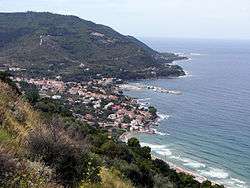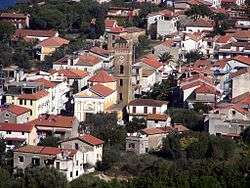San Marco (Castellabate)
| San Marco | |
|---|---|
| Frazione | |
 | |
 San Marco Location of San Marco in Italy | |
| Coordinates: 40°16′2.78″N 14°56′20.33″E / 40.2674389°N 14.9389806°ECoordinates: 40°16′2.78″N 14°56′20.33″E / 40.2674389°N 14.9389806°E | |
| Country |
|
| Region |
|
| Province | Salerno (SA) |
| Comune | Castellabate |
| Elevation | 15 m (49 ft) |
| Population (2009)[1] | |
| • Total | 1,139 |
| Demonym(s) | Sammarchesi |
| Time zone | CET (UTC+1) |
| • Summer (DST) | CEST (UTC+2) |
| Postal code | 84071 |
| Dialing code | (+39) 0974 |
| Patron saint | St. Mark |
| Saint day | 25 April |

San Marco is a southern Italian village and hamlet (frazione) of Castellabate, a municipality in the province of Salerno, Campania. As of 2009 its population was of 1,139.[1]
History
Settled since the Paleolithic, San Marco was the location of the Ancient Roman town of Erculia.[2] The village was first mentioned in 1168, identified as the farmhouse of Sancti Marci, part of the baronage of Castello dell'Abate. The original settlement extended behind the current port, and has expanded towards the end of the 20th century to the inland, due to its touristic growth.
Geography
Located in the central-northern side of Cilento, by the Tyrrhenian Sea, San Marco is extended from the national road 267, at the zone of Torretta, to the coast nearby the park of Licosa. It borders with the other frazione of Santa Maria and is 4 km far from Castellabate, 15 from Agropoli, 6 from Case del Conte, 11,5 from Agnone Cilento and 18 from Acciaroli. It counts a port that is served by hydrofoils[3] for passenger transport.[4][5]
Media
Benvenuti al Sud,[6] an Italian adaptation of the 2008 French film Bienvenue chez les Ch'tis, has been set in Castellabate and partly in Santa Maria and San Marco.[7]
Personalities
- Agostino Di Bartolomei (1955-1994), football player
- Marek Jackowski (1946-2013), polish rock musician
Gallery
-
Promenade nearby an Ancient Roman necropolis
-
The ancient tower of Torretta[1]
-
De Angelis Palace
See also
References
- 1 2 (Italian) Infos at italia.indettaglio.it
- ↑ (Italian) History of Castellabate
- ↑ (Italian) Hydrofoils in Cilento: timetables and infos
- ↑ (Italian) The port of San Marco at castellabateinfo.it
- ↑ (Italian) The port of San Marco on pagineazzurre.com
- ↑ Benvenuti al Sud at the Internet Movie Database
- ↑ (Italian) Article on the Corriere del Mezzogiorno
External links
![]() Media related to San Marco at Wikimedia Commons
Media related to San Marco at Wikimedia Commons